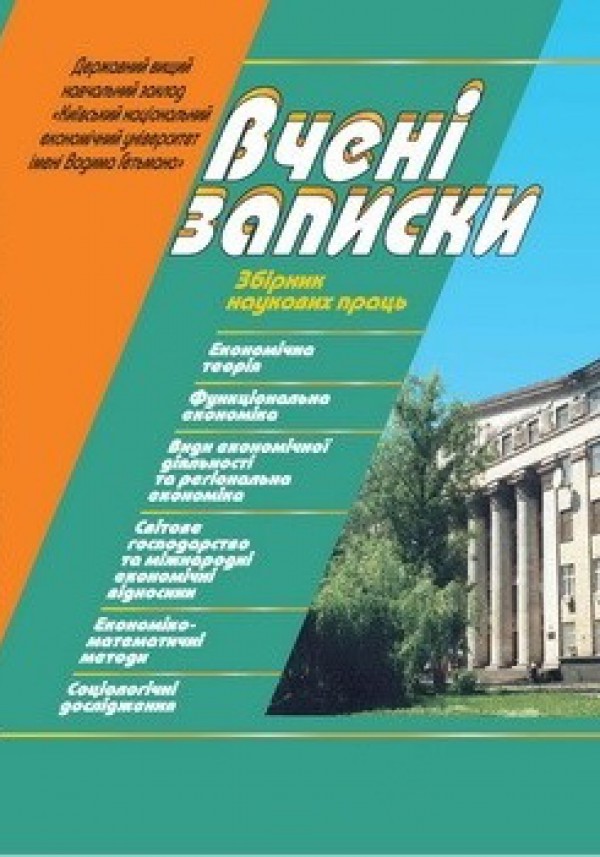
Collection of Scientific Papers "Scientific Notes"
ISSN 2415-8518
Економічна діагностика продовольчого стану країн в умовах глобальної нестабільності
Economic diagnostics of the country’s food situation amidst global instability
DOI:
10.33111/vz_kneu.22.21.01.01.005.011
Анотація: Розглянуто фактори впливу на обсяг експорту сільськогосподарської продукції протягом останніх двох десятиліть. За цей період обсяг експорту сільськогосподарських товарів зріс більше, ніж втричі, незважаючи на періодичні економічні кризи, які прямо впливали на агропродовольчу сферу країн і сповільнювали зростання експорту сільськогосподарських товарів. Оцінено можливий вплив пандемії внаслідок COVID-19 на агропродовольчу сферу. Зокрема, виокремлено можливі загрози, пов’язані зі збоєм у роботі продовольчих ланцюгів поставок, зростанням безробіття, зменшенням платоспроможного населення та обмеженням в’їзду мігрантівробочих для збору врожаю. Крім цього, виділено найуразливіші верстви населення, серед яких люди, які хронічно голодують, дрібні фермери, діти з малозабезпечених сімей, діти з обмеженими можливостями та люди, які крім пандемії зазнали інших критичних бід. Розраховано усереднені показники врожайності основних груп товарів у різних країн і проаналізовано залежність рівня ефективності ведення сільського господарства від рівня розвитку країни. Окрім розвинених країн, високі показники врожайності показали також деякі з країн-лідерів по експорту сільськогосподарських товарів, такі як Бризилія, Індонезія та Мексика. Охарактеризовано основні аспекти ефективного ведення сільського господарства у розвинених країнах, а саме, підтримка агропродовольчої сфери з боку держави, залучення іноземних інвестицій та імплементація результатів науково-технічного прогресу в усі стадії сільськогосподарського виробництва. Рекомендовано імплементувати окремі аспекти агропродовольчої політики розвинених країн у політику країн, що розвиваються, що посприяє не тільки зростанню врожайності, покращенню продовольчої забезпеченості країни, але й досягненню більшої частки в експорті товарів на глобальному ринку та покращенню економічної безпеки країни загалом.
Abstract: We have considered the factors influencing the agricultural exports over the past two decades. Exports of agricultural commodities more than tripled during that period, despite recurrent economic crises that directly affected the agri-food sector of the countries and slowed down the increase in the agricultural commodities exports. The possible impact of the COVID-19 pandemic on the agri-food sector has been assessed as well. In particular, we have identified the potential threats associated with the failures in food supply chains, rising unemployment, reducing number of solvent population and restrictions on the entry of migrant workers for harvesting. Moreover, we have identified the most vulnerable social groups, including people who are chronically starving, small farmers, disadvantaged children, children with disabilities and people who have suffered other critical disasters in addition to the pandemic. We have calculated the average yield indicators of the main groups of goods in different countries and analyzed the dependence of the agriculture efficiency on the country development level. In addition to developed countries, high yields were also shown by some countries leading in the exports of agricultural commodities, such as Brazil, Indonesia and Mexico. We have described the main aspects of efficient agriculture in developed countries, namely, state support of the agri-food sector, attraction of foreign investments and implementation of the scientific-andtechnological advance results at all stages of agricultural production. We recommend implementing certain aspects of agri-food policy of developed countries in that of developing ones, which will not only increase yields and improve food security but will also achieve a greater share in exports of goods in the global market and improve economic security in general.
Ключові слова: сільське господарство, COVID-19, пандемія, експорт агропродовольчих товарів, врожайність, агропродовольча забезпеченість
Key words: agriculture, COVID-19, pandemic, export of agri-food products, yield, agrifood security
УДК: 339.564.2
UDC: 339.564.2
JEL: F19 Q18
To cite paper
In APA style
Bibla, I. (2021). Economic diagnostics of the country’s food situation amidst global instability. Collection of Scientific Papers "Scientific Notes", 22 (1), 5-13. http://doi.org/10.33111/vz_kneu.22.21.01.01.005.011
In MON style
Бібла І.І. Економічна діагностика продовольчого стану країн в умовах глобальної нестабільності. Вчені записки. 2021. № 22(1). С. 5-13. http://doi.org/10.33111/vz_kneu.22.21.01.01.005.011 (дата звернення: 27.04.2025).
With transliteration
Bibla, I. (2021) Ekonomichna diahnostyka prodovolchoho stanu krain v umovakh hlobalnoi nestabilnosti [Economic diagnostics of the country’s food situation amidst global instability]. Collection of Scientific Papers "Scientific Notes", no. 22(1). pp. 5-13. http://doi.org/10.33111/vz_kneu.22.21.01.01.005.011 [in Ukrainian] (accessed 27 Apr 2025).
.jpg ) # 22(1) / 2021
# 22(1) / 2021
Download Paper
2
Views
0
Downloads
0
Cited by
- Glauber, J. W. (2020). The current state of agricultural trade and the World Trade Organization. International Food Policy Research Institute. Retrieved from: https://www.ifpri.org/news-release/current-state-agricultural-trade-and-world-tradeorganization.
- World Trade Statistical Review. (2020). World Trade Organization. Retrieved from: https://www.wto.org/english/res_e/statis_e/wts2020_e/wts2020chapter01_e.pdf.
- The State of Agricultural Commodity Markets. (2020). The Food and Agriculture Organization. Retrieved from: http://www.fao.org/3/cb0665en/CB0665EN.pdf.
- Siche, R. (2020). What is the impact of COVID-19 disease on agriculture? Scientia Agropecuaria, 11, 3–6. DOI: 10.17268/sci.agropecu.2020.01.00.
- Impact of COVID-19 on agriculture, food systems and rural livelihoods in Eastern Africa: Policy and programmatic options. (2020). The Food and Agriculture Organization. Retrieved from: http://www.fao.org/3/cb0552en/CB0552EN.pdf.
- Food Outlook — Biannual Report on Global Food Markets. (2020). The Food and Agriculture Organization. Retrieved from: http://www.fao.org/3/ca9509en/CA9509EN.pdf.
- Novel Coronavirus (COVID-19). Retrieved from: http://www.fao.org/2019-ncov/q-anda/impact-on-food-and-agriculture/en/.
- OECD‑FAO Agricultural Outlook 2020–2029. (2020). The Food and Agriculture Organization. Retrieved from: https://www.oecd-ilibrary.org/docserver/1112c23ben.pdf?expires=1611785582&id=id&accname=guest&checksum=5D905A533D184E8584B9 27CE6928343D.
- Poudel, P., Poudel, M., & Gautam, A. (2020). COVID-19 and its Global Impact on Food and Agriculture. Journal of Biology and Today’s World, 9, 1–4. DOI: 10.35248/2322- 3308.20.09.221.
- COVID-19: Channels of transmission to food and agriculture. (2020). The Food and Agriculture Organization. Retrieved from: http://www.fao.org/3/ca8430en/CA8430EN.pdf.
- Varshney, D., Roy, D., Meenakshi, J. (2020) Impact of COVID-19 on agricultural markets: assessing the roles of commodity characteristics, disease caseload and market reforms. Indian Economic Review, 55, 83–103. DOI: 10.1007/s41775-020-00095-1.
- Zurayk, R. (2020) Pandemic and food security: A view from the Global South. Journal of Agriculture, Food Systems, and Community Development, 9, 17–21. DOI: 10.5304/jafscd.2020.093.014.
- The World Bank. (2020). Retrieved from: https://www.worldbank.org/.
- FAOSTAT. (2020). Retrieved from: http://www.fao.org/faostat/en/#data/QC.
- Zhukenov. B. (2014). Zarubezhnyj opyt innovacionnogo razvitija agropromyshlennogo kompleksa. Retrieved from: http://cyberleninka.ru/article/n/ zarubezhnyy-opyt-innovatsionnogo-razvitiya-agropromyshlennogo-kompleksa.

